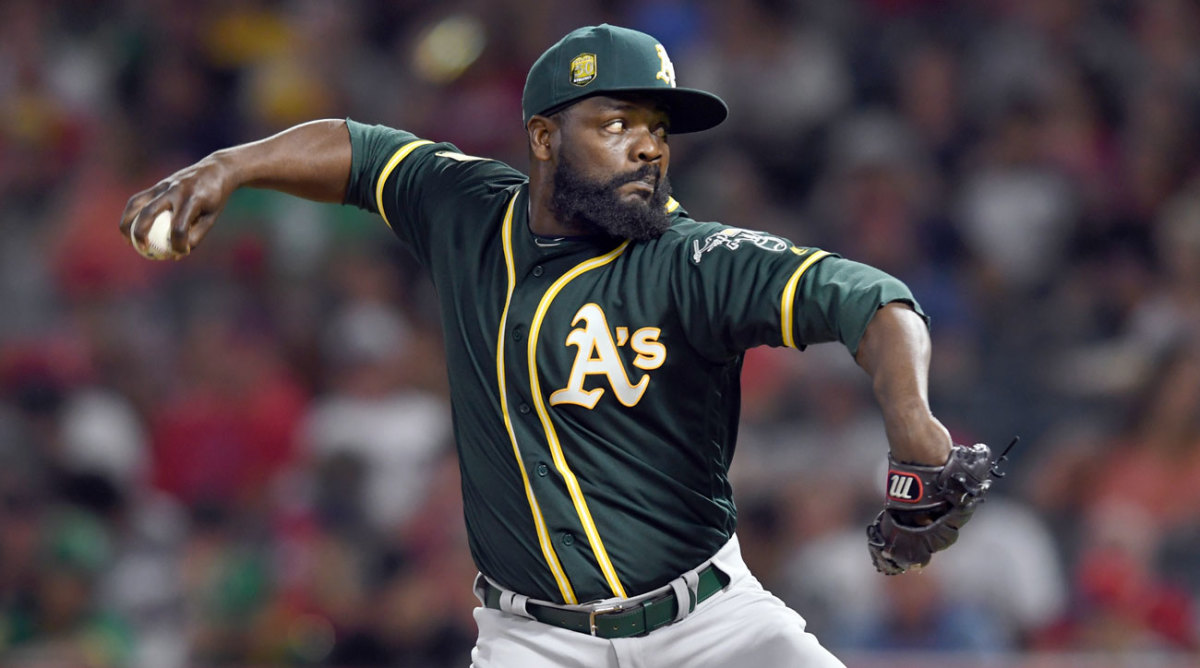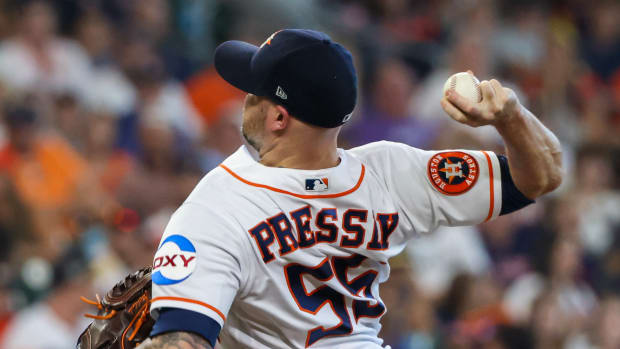Should the A's Turn to Bullpenning for the Wild Card Game? They Should Certainly Consider It
UPDATE: After the publication of this article, the A's confirmed that Trevor Cahill would miss his Saturday start with an injury.
One by one, Athletics starters keep biting the dust. The latest to fall is Sean Manaea, the staff ace who’s been out since Aug. 26 with a left shoulder strain and is now officially done for the year—and perhaps 2019 as well—following news on Tuesday that he needs arthroscopic surgery. His departure leaves Oakland with just three starters in its rotation—and, more importantly, no clear answer on whom to start in the AL wild-card game.
In hitting the disabled list, Manaea joins a long list of A’s starters who have succumbed to injury. The butcher’s bill includes Manaea, Brett Anderson (forearm strain), Daniel Gossett (Tommy John surgery), Paul Blackburn (lateral epicondylitis, aka tennis elbow), Andrew Triggs (nerve irritation in his arm), and Opening Day starter Kendall Graveman (Tommy John surgery). There’s also Jharel Cotton and top prospect A.J. Puk, both of whom suffered torn ulnar collateral ligaments in spring training and were thus lost before the season even started.
That’s a lot of bodies on the disabled list—including four-fifths of Oakland’s Opening Day rotation; Daniel Mengden is the only member of that group still standing—but Manaea’s loss hurts the most. The 26-year-old lefty was having a career year, with a 3.59 ERA, 114 ERA+ and 2.6 Wins Above Replacement (Baseball-Reference version) in 160 2/3 innings. The best pitcher in a thin rotation, Manaea was Oakland’s most dependable and high-upside arm.
Without him, the starting five has been reduced to a trio: Mike Fiers, Trevor Cahill, and Edwin Jackson, not one of whom was with the A’s on Opening Day. Cahill began the year in Triple A, got called up on April 17, and has pitched well around a pair of DL stints, with a 3.77 ERA and 109 ERA+ in 102 2/3 innings. Fiers, picked up from the Tigers in an August waiver trade, has been sensational since putting on green-and-gold, with a 2.72 ERA and 42 strikeouts in 39 2/3 frames across seven starts. And peripatetic veteran Jackson was called up from the minors on June 1 and been a savior for his 13th major league team, with a 3.26 ERA across 77 1/3 innings and 14 starts.
It’s as unlikely a trio as you can imagine carrying the weight for the A’s, but they’re getting the job done. Behind them, though, Oakland has nothing. The fourth spot in the rotation currently belongs to veteran reliever Liam Hendriks, with the A’s aping the Rays’ opener strategy and letting him pitch the first inning before handing it off to the bullpen.
The good news for the A’s is twofold. One, the lack of starters hasn’t impacted their winning ways: They’re 8–2 in September, have won six straight games and are within three games of the first-place Astros in the AL West and one game of the Yankees for the first wild card. Second, Oakland has plenty of cushion to work with, holding a 9 ½-game lead over the Mariners in the division and an 8 ½-game advantage on the Rays in the wild-card race. Barring an improbable collapse, the A’s can survive what’s left of the season without a full rotation and make the playoffs easily. (Plus, they’re getting Anderson back on Thursday, which should help at least somewhat.)
The problem comes once the calendar flips to October. As noted, the A’s are within striking distance of the Astros in the AL West, but there are only 16 games remaining season with no head-to-head matchups left with Houston. Concurrently, Oakland’s odds of chasing down the defending world champs are slim: Even with their current hot streak, Fangraphs gives the A’s just a 3.3% chance of winning the division. More likely is a date with the Yankees in the wild-card game, and that’s where Manaea’s injury makes things tricky, as he would’ve been the easy choice to start that contest. Instead, that responsibility will likely fall to one of Cahill, Fiers or Jackson (or possibly Anderson). But while all of them have done solid work this season, if you’re an A’s fan, do you feel comfortable seeing any of those four standing on the mound at Yankee Stadium in a do-or-die game?
There are arguments you can make for them. Cahill is a groundball machine who has been surprisingly strong multiple times through an order (a .642 OPS the third time around compared to the league average of .789), but he allows too much hard contact and doesn’t get many strikeouts. Fiers racks up strikeouts but is very homer prone (seven in 39 2/3 innings with the A’s) because of a high fly-ball rate—fine in the cavernous Oakland Coliseum, less appealing when faced with Yankee Stadium’s short rightfield porch. Jackson has heroically stepped up, but he’s a 34-year-old journeyman with peripherals that suggest he’s closer to a 5.00 ERA pitcher and who shouldn’t be allowed to face a lineup more than once. And Anderson is a soft-tossing lefty who gets clobbered by righties and also can’t be trusted to navigate a batting order multiple times.
The best you can hope for from anyone in that quartet is a five-and-fly night followed by the bullpen. That’s to the Athletics’ benefit, as their relief corps is one of MLB’s best: The team’s 3.21 relief ERA is the second lowest in baseball. So why not simply hand over the entire game to that group and let them navigate that ruthless Yankees lineup instead of closing your eyes and praying that Fiers or Cahill can emerge unscathed? The odds are against any starter in that group going more than four innings anyway.
Unlike its rotation, Oakland’s bullpen is ludicrously deep and full of talent. Closer Blake Treinen has a 0.87 ERA and 94 strikeouts in 72 1/3 innings. Rookie Lou Trivino has a 2.18 ERA and 78 punchouts in 70 1/3 frames. Former Mets closer Jeurys Familia has a 2.45 ERA and 33 strikeouts in 25 2/3 innings (albeit with 12 walks) since coming over in a late July trade. The erratic Fernando Rodney, acquired from the Twins in August, has 16 whiffs in 15 2/3 innings. And righty Shawn Kelley hasn’t allowed a run in 12 appearances since being claimed off waivers after the Nationals dumped him in early August. Beyond that, manager Bob Melvin also has veteran long reliever Yusmeiro Petit (a 3.14 ERA in 86 innings) and southpaw Ryan Buchter (.179/.243/.284 against lefties this season) as options.
Between those seven relievers, Melvin should be able to stitch together nine effective innings without having to trust one of his shakier starters. Treinen, Familia, Petit and Trivino are all capable of going multiple innings. All of those pitchers would be fully rested, with two days between the end of the season and the wild-card game, and would get a day off afterward before the Division Series, leaving them ready to go for Game 1. And Treinen, Familia and Trivino are all tough on righties, making them ideal weapons against the Yankees’ righty-heavy lineup.
The idea of bullpenning a must-win game in the postseason may seem scary, but for the A’s, it feels like a safer bet. Why throw an average pitcher out against a terrific lineup when you can just roll out a constant stream of elite relievers instead? The Yankees basically did that in last year’s wild-card game against the Twins, albeit unintentionally: When starter Luis Severino was knocked out in the first inning, four relievers—Chad Green, Tommy Kahnle, David Robertson, and Aroldis Chapman—combined to get the final 26 outs of New York’s win. It’s a strategy that can work if you have the right personnel, and the A’s absolutely do.
Melvin still has two weeks to figure out what he wants to do for his team’s first trip to the playoffs in four years. Last time around, he had an easy call: He gave the ball to tested postseason ace Jon Lester, who nevertheless struggled against the Royals. This season, his choice will be much tougher. Here’s a vote, then, for the unconventional option.





































